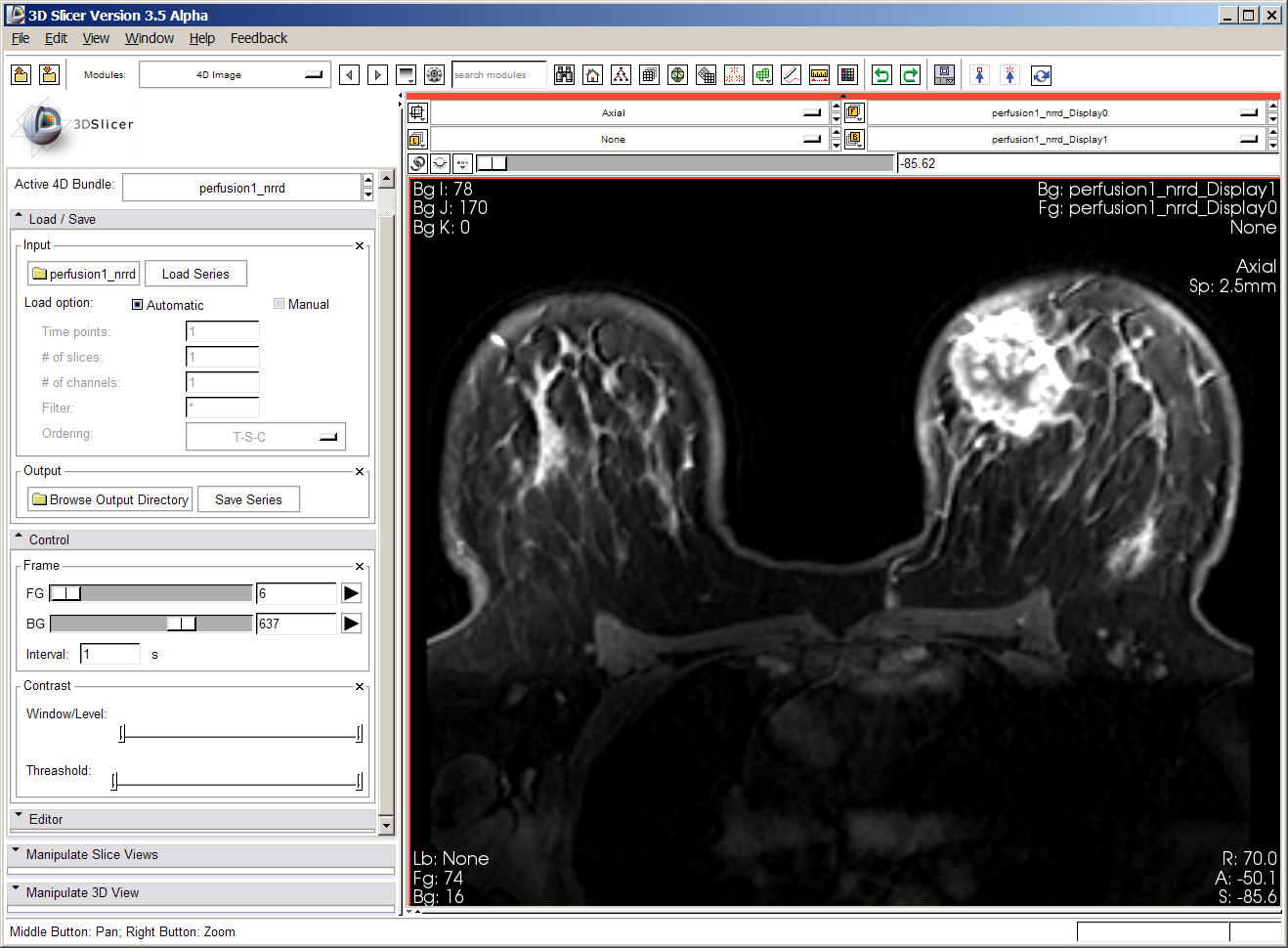Difference between revisions of "Slicer3:UIDesign:WorkingProblems:BCAnalysis:Dynamic"
| Line 47: | Line 47: | ||
* Changed some code in vtkFourDAnalysisLogic.cxx because there is no equivalent to the isnormal() function. Instead, just used the same def for finite()... but this will not test for subnormal floats. | * Changed some code in vtkFourDAnalysisLogic.cxx because there is no equivalent to the isnormal() function. Instead, just used the same def for finite()... but this will not test for subnormal floats. | ||
* Had to move pyconfig.h to Slicer3-lib/python-build/Include so FourDAnalysis module could compile (couldn't find this file, included by <Python.h> for some reason (maybe something wrong with my python install. | * Had to move pyconfig.h to Slicer3-lib/python-build/Include so FourDAnalysis module could compile (couldn't find this file, included by <Python.h> for some reason (maybe something wrong with my python install. | ||
| − | * Still problem linking -- can't open python25_d.dll during link -- | + | * Still problem linking -- can't open python25_d.dll during link -- |
| + | ** turns out that building Debug rather than release creates python25.dll and python25_d.dll both. the compile in genlib only builds python in release mode. Try changing the mode to ::$VTK_BUILD_TYPE and copy the python25_d.dll (as well as python25.dll to the python-build/Lib dir) in genlib.tcl... | ||
| + | *** compiling python in debug mode does not generate the release libarary as described. So, next thing to try is running the python build twice, once in release, once in debug. made this change in genlib.tcl, and did the file copy of both the dlls. | ||
| + | *** then, in subsequent call in getbuildtest.tcl, had to put a catch around the python lib file copy -- and add a copy of the debug library too. | ||
Revision as of 16:27, 20 August 2009
Home < Slicer3:UIDesign:WorkingProblems:BCAnalysis:DynamicBack to Project Overview
Contents
Perfusion Analysis for Breast Cancer
Goal
Goal is to accommodate basic RECIST assessment for breast cancer (Response Evaluation Criteria In Solid Tumors). (RECIST is a set of published rules that define when cancer patients improve ("respond"), stay the same ("stable") or worsen ("progression") during treatments).
- Determine features that currently exist in Slicer
- Develop features that don't
- Provide a framework that knits features together in a comfortable workflow.
Perfusion Analysis Workflow
- Visualize the dataset dynamically
- Specify an ROI that includes tumor and apply to all timepoints Question: ROI or VOI? (either -- if slice, must be same slice)
- Plot contrast dilution curve
- show time to peak in tumor
- Specify an ROI that includes blood pool and apply to all timepoints Question: again, ROI or VOI?
- Plot contrast dilution curve for this (on same graph)
- show time to peak in blood pool
- show transit time (distance between peaks in each plot)
- save out timepoints ( Intensity(t) for each ROI -- include multiple tumors if desired)
First experiment
Below is a screenshot of first perfusion dataset. The dataset contains upward of 900 volumes. Loading the original DICOM images took a very long time; Junichi converted these images to nrrd format, but the loading still takes prohibitively long, and interacting is also very slow.
ideas:
- can we create a VOI and apply to each volume in the timeseries?
- Alternatively, for a first demo we can use a smaller dataset?
update:
From Jeff -- first dataset contains 15 timepoints, each 256x256x63 -- so we've found a bug in either:
- the timeseries loader in Slicer (probably in the thing that parses dicom header), or
- we have a malformed DICOM header.
This is causing Slicer to load 63x15 volumes containing a single 256x256 slice. I'll dig in to this today and see what's going on. Shouldn't be too hard to find. Junichi has given me a DCE dataset that loads properly for comparison.
The 4D Image analysis package is required for plotting -- need to expose this in Slicer3/Modules/CMakelists.txt file. Discussed with Junichi about possibility of having both 4DImage and 4DImageAnalysis modules exposed in the trunk for the demo; he sees no problem in this *without* the Scipy modeling part exposed. Too challenging now to build python/numpy/scipy by default.
CHANGES TO CODE to get FourDImage and FourDAnalysis to compile
- Exposed FourDImage and FourDAnalysis modules in Slicer3/Modules/CMakelists.txt
- Changed the code in vtkKWPlotGraph.cxx: replaced finite() function is replaced code that conforms to ISO C++/2003 so it would compile on win32
- Changed some code in vtkFourDAnalysisLogic.cxx because there is no equivalent to the isnormal() function. Instead, just used the same def for finite()... but this will not test for subnormal floats.
- Had to move pyconfig.h to Slicer3-lib/python-build/Include so FourDAnalysis module could compile (couldn't find this file, included by <Python.h> for some reason (maybe something wrong with my python install.
- Still problem linking -- can't open python25_d.dll during link --
- turns out that building Debug rather than release creates python25.dll and python25_d.dll both. the compile in genlib only builds python in release mode. Try changing the mode to ::$VTK_BUILD_TYPE and copy the python25_d.dll (as well as python25.dll to the python-build/Lib dir) in genlib.tcl...
- compiling python in debug mode does not generate the release libarary as described. So, next thing to try is running the python build twice, once in release, once in debug. made this change in genlib.tcl, and did the file copy of both the dlls.
- then, in subsequent call in getbuildtest.tcl, had to put a catch around the python lib file copy -- and add a copy of the debug library too.
- turns out that building Debug rather than release creates python25.dll and python25_d.dll both. the compile in genlib only builds python in release mode. Try changing the mode to ::$VTK_BUILD_TYPE and copy the python25_d.dll (as well as python25.dll to the python-build/Lib dir) in genlib.tcl...
